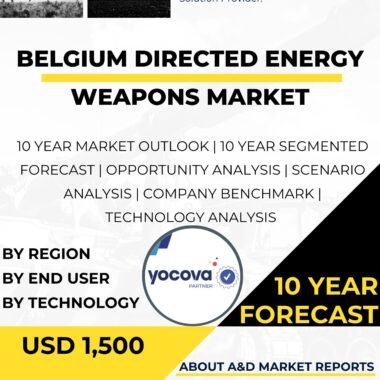Description
The Sweden Directed Energy Weapons (DEW) Market has emerged as a pivotal player in the country’s defense industry, representing the cutting edge of modern warfare technology. Directed Energy Weapons harness the power of highly focused energy, such as lasers or microwaves, to engage and neutralize targets with precision and speed. These advanced weapons have the potential to revolutionize military capabilities, offering advantages in terms of accuracy, reduced collateral damage, and cost-effectiveness compared to traditional kinetic weapons. Sweden’s commitment to innovation, technological expertise, and defense modernization has positioned it as a key contributor to the global DEW market.
The Sweden Directed Energy Weapons Market encompasses a wide range of applications, including land, air, and naval platforms. These innovative weapons hold the promise of enhanced military effectiveness, bolstering Sweden’s defense capabilities and augmenting its position as a technologically advanced defense force.
One of the primary applications of Directed Energy Weapons in the Sweden Directed Energy Weapons Market is in the field of air defense. DEW systems can be deployed on airborne platforms, such as fighter jets or drones, to engage and disable enemy aircraft and missiles. High-energy lasers, for example, can rapidly track and engage incoming threats, providing a rapid response to aerial threats while minimizing the risk of collateral damage.
Moreover, the Sweden Directed Energy Weapons Market caters to the development and implementation of DEW systems for land-based applications. Mobile and fixed land-based DEW installations can serve as potent countermeasure systems, protecting military installations and critical infrastructure against airborne threats. Additionally, DEW systems can be integrated into ground vehicles, providing an extra layer of protection against enemy threats on the battlefield.
In addition to air and land-based applications, the Sweden Directed Energy Weapons Market also focuses on naval platforms. DEW systems mounted on naval vessels offer the potential to counteract maritime threats, such as enemy ships, drones, or anti-ship missiles. The precision and speed of DEW systems provide naval forces with a powerful means to defend against various threats at sea.
The Sweden Defense Directed Energy Weapons Market is characterized by a strong emphasis on research and development (R&D) activities. The defense industry collaborates closely with research institutions and the Swedish Armed Forces to drive technological advancements in DEW systems. This collaboration fosters the development of state-of-the-art Directed Energy Weapons, ensuring that they meet the rigorous demands of modern warfare.
Furthermore, the market has seen significant advancements in laser technologies, which lie at the core of many Directed Energy Weapons. Continuous research and technological breakthroughs have led to more compact, powerful, and efficient laser systems, increasing the overall effectiveness of DEW applications.
Moreover, the integration of advanced tracking and targeting systems has further enhanced the precision and accuracy of DEW platforms. These systems enable swift and accurate engagements of moving targets, making DEW an attractive choice for tackling agile and maneuverable threats.
The Sweden Directed Energy Weapons Market also addresses the challenge of power and energy supply for DEW systems. The need for sufficient energy to operate these high-powered weapons has led to the development of advanced power management and storage solutions to ensure sustained and reliable performance during engagements.
The adoption of Directed Energy Weapons in Sweden’s defense arsenal is also influenced by its role in the broader European and global defense landscape. The interoperability of DEW systems with other allied nations’ defense platforms enhances their effectiveness in multinational operations and coalition missions. Collaboration and information sharing among nations contribute to the continuous development and refinement of Directed Energy Weapons.
Despite the immense potential and progress in DEW technology, there are still challenges and considerations in the market. Cost-effectiveness and scalability are vital factors in the adoption of Directed Energy Weapons. While these systems offer significant advantages in precision and reduced logistics, their development and acquisition costs can be substantial.
Furthermore, the effectiveness of DEW systems can be influenced by environmental factors, such as atmospheric conditions. Weather and other environmental variables may impact the performance and range of Directed Energy Weapons, necessitating robust testing and validation processes.




